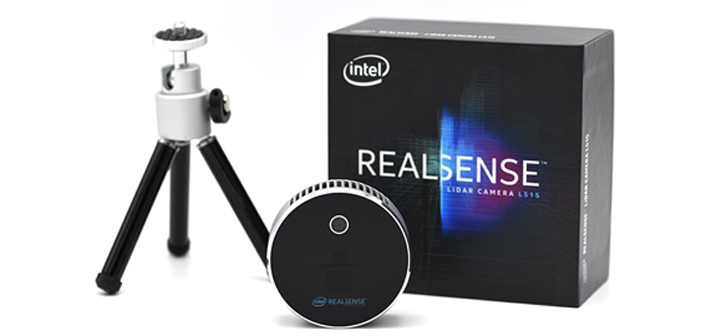Well-known chip maker Intel has announced the release of the L515, the company’s first lidar camera, aiming to redefine computer vision by enabling highly accurate depth sensing in a small form factor.
To distinguish itself from other lidar sensors in the market, the L515 takes advantage of Intel’s RealSense technology which uses an advanced, miniaturized micro-electro-mechanical system mirror to scan the scene. This way, it reduces the laser pulse power, “achieving the world’s smallest, most power-efficient, high-resolution lidar”.
Small enough to fit in the palm of your hand (61mm in diameter and 26mm in height), the L515 weighs approximately 100g, runs at less than 3.5W, and features an FHD RGB camera, an inertial measurement unit (IMU), an accelerometer, and gyroscope. Also, it supports a range of 0.25m – 9m, and includes an internal vision processor, motion blur artifact reduction and short photon-to-depth latency.
Capable of generating 23 million accurate depth points with a 1024×768 resolution at 30 frames per second, the L515 works for a wide variety of applications. For example, the logistics industry can benefit from the high resolution and full scene perception, while companies looking for inventory management automation benefit from precise volumetric measurement of products, enabling an accurate state of inventory at all times. According to Intel, many other applications for the L515 can be found in 3D scanning, healthcare, retail, robotics and more.
Since infrared light from the sun can interfere with the performance of the device degrading the quality of the depth images when used outdoors, Intel claims the lidar camera will perform best indoors or in controlled lighting conditions. Although the L515 doesn’t feature a 360º field-of-view (70° × 55°), it’s possible to use multiple cameras so they can share the same field of view through Intel’s hardware sync feature.
Throughout the years, Intel’s RealSense technology has been used in different use cases, including capturing 3D point clouds and converting to a mesh with MeshLab, performing 3D measurements with a rugged handheld device, providing drones with obstacle-avoidance, and helping cultural preservation efforts. The addition of a lidar sensor to the RealSense family extends the possibilities for professionals to create new ways to apply the technology. According to Sagi BenMoshe, corporate vice president of the Intel RealSense Group, Intel envisions a variety of potential applications.
“Intel RealSense technology is used to develop products that enrich people’s lives by enabling machines and devices to perceive the world in 3D. With the L515 depth camera, we are excited to bring high-resolution lidar performance to markets previously inaccessible to this technology.”
As with previous devices in the RealSense family, the company’s open‑source SDK 2.0 also works with the L515, offering a variety of wrappers supporting popular programming languages and platforms, and allowing an easy transition from any of the other RealSense depth cameras.
Priced at $349, the L515 lidar camera is now available for pre-order.






